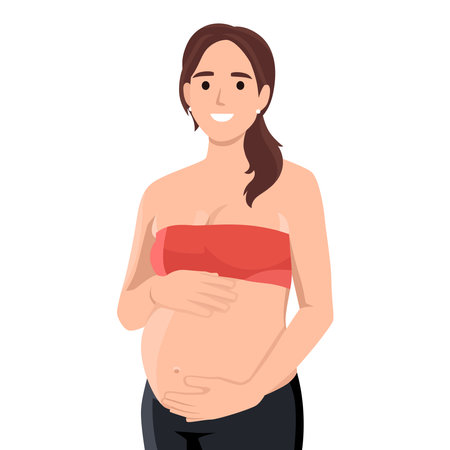Introduction to Ergonomic Baby Carriers
Choosing the right baby carrier is an important decision for every parent, especially when considering your childs comfort and healthy development. An ergonomic baby carrier is specifically designed to provide proper support to a babys hips and spine, ensuring both safety and comfort during use. But what does “ergonomic” really mean in this context, and why is it so crucial for your little one?
Ergonomics refers to designing products that fit the human body’s natural structure and movement. For baby carriers, this means supporting the babys legs in a spread-squat or “M” position—where knees are higher than the bottom—and keeping the spine in its natural, slightly rounded shape. This positioning is vital for preventing hip dysplasia and encouraging healthy spine development.
The table below outlines key differences between ergonomic and non-ergonomic carriers:
| Feature | Ergonomic Carrier | Non-Ergonomic Carrier |
|---|---|---|
| Hip Position | M-shaped, knees above bottom | Legs hang straight down |
| Spine Support | Supports natural curve | Straightens or flattens back |
| Weight Distribution | Evenly across hips & shoulders | Mainly on crotch & lower back |
| Comfort for Parent | Reduces shoulder/back strain | Can cause discomfort with prolonged use |
Selecting an ergonomic carrier isn’t just about convenience; it’s about fostering your baby’s healthy physical growth. As you explore various options, understanding these foundational principles will help ensure you make the best choice for your family.
Understanding Baby Hip and Spine Development
Infant musculoskeletal growth is a delicate process that lays the foundation for lifelong mobility and health. In the first year, babies’ bones, joints, and muscles are rapidly developing. At birth, an infant’s spine is shaped like a gentle C-curve, which gradually straightens as they grow and begin to lift their heads, roll over, and eventually sit up. The hips are also in a formative stage—newborns have soft cartilage around the hip sockets that slowly hardens into bone.
Pediatricians in the United States emphasize the importance of supporting this natural development. According to recommendations from the American Academy of Pediatrics (AAP) and the International Hip Dysplasia Institute (IHDI), proper support for both the hips and spine can help prevent conditions such as hip dysplasia and promote healthy posture as your child grows.
Key Milestones in Musculoskeletal Growth
| Age | Spine Development | Hip Development |
|---|---|---|
| 0-3 months | C-curve spine; head control begins | Hips are very flexible; shallow sockets |
| 4-6 months | Neck strength increases; starts rolling over | Sockets deepen with movement; legs open naturally when held upright |
| 7-12 months | Sitting independently; lumbar curve forms | Continued ossification; stable hip joints form with proper support |
Pediatric Guidelines for Healthy Development
The AAP recommends “spread-squat” positioning for infants when carried or seated, where the knees are higher than the buttocks and legs are spread apart in an M-shape. This position supports both the spine’s natural curve and proper hip alignment. Avoiding straight-legged swaddling or carriers that let legs dangle can reduce the risk of hip dysplasia.
Why Ergonomic Support Matters
An ergonomic baby carrier helps maintain these ideal positions by providing structured but gentle support for your baby’s back and hips. Following pediatric guidelines not only encourages comfort but also contributes to healthy physical development during these critical early months.

3. Key Features of Ergonomic Carriers
When selecting an ergonomic baby carrier, it’s essential to focus on design features that promote healthy hip and spine development for your baby while ensuring comfort for the caregiver. Not all carriers are created equal, so understanding what to look for can make a big difference in both safety and usability.
Essential Design Elements
Below is a breakdown of the most important ergonomic features to consider:
| Feature | Description | Why It Matters |
|---|---|---|
| Wide, Deep Seat | Supports baby from knee to knee, creating an “M” shaped position. | Promotes healthy hip alignment and reduces risk of hip dysplasia. |
| Adjustable Straps | Easily customizable shoulder and waist straps for different caregivers. | Ensures a snug fit, distributing weight evenly and reducing strain. |
| Lumbar Support | Padded support panel at the lower back. | Provides extra comfort for parents during extended wear. |
| Head and Neck Support | Structured headrest or adjustable panels. | Keeps infants’ heads properly supported, especially for newborns. |
| Breathable Fabrics | Materials that allow airflow and wick moisture. | Keeps both baby and caregiver cool and comfortable. |
User-Friendly Adjustments
An ergonomic carrier should offer easy adjustments to accommodate growing babies and different body types among caregivers. Look for buckles, sliders, or Velcro that allow you to quickly modify the fit as needed without removing the carrier. This adaptability ensures ongoing support as your child grows from infancy into toddlerhood.
Additional Comfort Considerations
Padded shoulder straps help distribute your baby’s weight more evenly across your shoulders, preventing discomfort during longer outings. Some carriers also offer crossable or straight strap options to suit personal preference or body type. A wide waistband further aids in relieving pressure from your back and shoulders—key for busy American parents who may be on the move throughout the day.
4. Different Types of Baby Carriers and Their Benefits
When it comes to choosing an ergonomic baby carrier, understanding the different styles available can help you make the best decision for your child’s hip and spine health as well as your own comfort. Each type of carrier offers unique advantages and potential drawbacks depending on your family’s lifestyle and your baby’s needs. Below, we compare four popular types: wraps, slings, soft-structured carriers (SSCs), and backpack carriers.
| Carrier Type | Pros | Cons |
|---|---|---|
| Wraps |
|
|
| Slings |
|
|
| Soft-Structured Carriers (SSC) |
|
|
| Backpack Carriers |
|
|
Selecting the right baby carrier style depends on your specific needs, your child’s developmental stage, and how you plan to use the carrier. For optimal hip and spine support, always check that any style you choose keeps your babys knees higher than their bottom in a natural “M” shape, especially during long periods of carrying.
5. Tips for Safe Babywearing
Ensuring your babys hips and spine are properly supported during babywearing is essential for healthy development and comfort. Here are practical tips and guidelines to help parents maintain safe and ergonomic positioning, manage duration, and monitor their babys well-being while using an ergonomic carrier.
Guidance on Positioning
The way you position your baby in a carrier has a significant impact on their hip and spinal health. Always follow these key principles:
| Aspect | Recommendation |
|---|---|
| Hip Position | Ensure your babys knees are higher than their bottom, forming an “M” shape with the legs. This supports healthy hip development and reduces the risk of hip dysplasia. |
| Spine Alignment | Your babys back should be supported in its natural curve, not forced straight or overextended. The carrier should hold them snugly against your body. |
| Head Support | For infants without full head control, make sure the carrier provides adequate support to prevent the head from flopping backward or sideways. |
| Visibility & Airway | Your babys face should always be visible, with their chin off their chest to ensure clear airways. You should be able to kiss the top of your babys head easily. |
Duration: How Long is Too Long?
While ergonomic carriers allow you to keep your baby close for extended periods, it’s important to give both you and your child regular breaks. Most experts recommend:
- For newborns: Limit continuous carrying to 1-2 hours before taking a break for stretching, diaper changes, or feeding.
- For older babies: Watch for cues that your baby wants to move around or change positions, typically every 2-3 hours.
- Your own comfort matters too: If you begin to feel discomfort or fatigue, take a break to avoid strain or injury.
Monitoring Your Baby While Wearing
Always check on your baby frequently while they’re in the carrier. Here are some tips for safe monitoring:
- Check leg positioning: Make sure your babys thighs are well-supported from knee to knee and the legs are not dangling straight down.
- Observe temperature: Babies can get warm quickly when held close, so dress them appropriately and check for overheating (sweating, flushed skin).
- Watch for signs of discomfort: Fussiness, slouching, or unusual quietness may indicate improper positioning or discomfort. Adjust as needed.
- Inspect the carrier regularly: Check straps, buckles, and fabric for wear and tear to ensure continued safety.
The T.I.C.K.S Rule for Safe Babywearing
This easy-to-remember guideline is widely recommended in the U.S. among babywearing communities:
| T.I.C.K.S Rule | Description |
|---|---|
| Tight | The carrier should hold your baby close and tight against you. |
| In view at all times | You should always be able to see your babys face without moving any fabric. |
| Close enough to kiss | Your babys head should be as close to your chin as comfortable. |
| Keep chin off chest | Your babys chin should not be pressed into their chest; there should be at least one fingers width of space under their chin. |
| Supported back | Your babys back should be supported in its natural position so they dont slump or lean away from you. |
Conclusion
By following these tips for safe babywearing—proper positioning, mindful duration, and vigilant monitoring—you can confidently support your babys healthy hip and spine development while enjoying the closeness that ergonomic carriers provide.
6. Common Myths and Misconceptions
When it comes to babywearing, particularly with ergonomic baby carriers, there are several myths and misconceptions that often circulate within U.S. parenting communities. These misunderstandings can lead to hesitation or misuse of carriers, potentially affecting both parental confidence and infant well-being. Let’s set the record straight by addressing some of the most common myths and providing facts based on current research and pediatric recommendations.
Myth vs. Fact: Understanding Baby Carrier Safety
| Myth | Fact |
|---|---|
| Baby carriers cause hip dysplasia | Properly designed ergonomic carriers support healthy hip development by keeping babys legs in the “M” position, as recommended by the International Hip Dysplasia Institute. |
| Carriers are unsafe for newborns | Most ergonomic carriers come with newborn inserts or adjustments to support safe carrying from birth, as long as manufacturer guidelines are followed. |
| Wearing a baby spoils them | Pediatricians agree that responsive parenting, including babywearing, fosters secure attachment and does not spoil babies. |
| Only certain body types can use carriers comfortably | Most modern carriers offer adjustable straps and waistbands to fit a wide range of body types, making comfort accessible for nearly all caregivers. |
Addressing U.S. Parenting Concerns
In American culture, some parents worry about convenience, physical strain, or social perceptions when using baby carriers. However, studies show that ergonomic designs distribute weight evenly, reducing back pain compared to traditional carriers or holding a child in arms. Additionally, many parents find babywearing enhances their mobility—essential for active lifestyles and multitasking at home or on-the-go.
Social Acceptance & Support Networks
The popularity of babywearing groups, classes, and online forums across the United States reflects increasing acceptance and education about safe practices. Connecting with these communities can dispel fears and provide hands-on guidance tailored to individual needs.
Busting the Biggest Myth: It’s Not “One Size Fits All”
No single carrier style suits every family or situation. The key is finding an ergonomic option that offers proper hip and spine support while meeting your unique lifestyle needs. Consulting certified babywearing educators or pediatricians can help you make an informed choice—and enjoy all the benefits of safe, comfortable babywearing.
7. Recommended Brands and Resources
Choosing a baby carrier that is both ergonomic and safe can feel overwhelming, especially with so many options available in the U.S. market. To help simplify your search, we’ve compiled a shortlist of reputable brands that are known for their commitment to ergonomic design, ensuring optimal hip and spine support for your baby. Below you’ll also find resources for further information on babywearing safety and best practices.
Top Ergonomic Baby Carrier Brands in the U.S.
| Brand | Main Features | Where to Buy |
|---|---|---|
| Ergobaby | Multiple carrying positions, lumbar support, newborn-friendly inserts, certified “hip-healthy” by the International Hip Dysplasia Institute (IHDI) | Amazon, Target, BuyBuy Baby, official website |
| Beco Baby Carrier | Wide seat base, adjustable straps, suitable from infancy to toddlerhood, machine washable | Amazon, Walmart, specialty baby stores |
| LILLEbaby | Six carrying positions, adjustable neck support, lumbar support waist belt | Amazon, Target, LILLEbaby website |
| Tula Baby Carriers | Breathable fabrics, ergonomic M-position seating, stylish designs | Target, Amazon, Tula website |
| Boba | Soft structured carriers and wraps, supports natural hip development, fits a wide range of body types | Amazon, BuyBuy Baby, Boba website |
Additional Resources for Parents and Caregivers
- The International Hip Dysplasia Institute (IHDI): Offers guidelines on healthy hip positioning in carriers and recommends “hip-healthy” products.
- Babywearing International: Provides evidence-based information on safe babywearing practices and local babywearing groups across the U.S.
- The American Academy of Pediatrics (AAP): Shares recommendations for safe babywearing and spinal health for infants.
- YouTube & Parenting Blogs: Look for instructional videos and real parent reviews from trusted sources before making a purchase.
Quick Tips Before You Buy:
- Check Certifications: Look for carriers certified by organizations like IHDI or that follow ASTM safety standards.
- Try Before You Buy: Many retailers allow you to try on carriers—take advantage of this to ensure comfort for both you and your baby.
- Consult Your Pediatrician: If your child has any special needs or you have concerns about hip or spine health, get medical advice before choosing a carrier.
Your Next Steps:
Selecting an ergonomic baby carrier is a personal choice that should balance safety, comfort, and lifestyle needs. Use these trusted brands as a starting point in your search. For more detailed guidance or hands-on help with fitting your carrier correctly, connect with local parenting groups or certified babywearing educators in your area.


